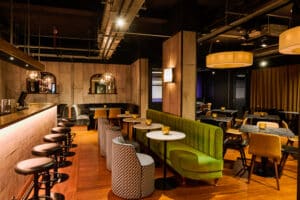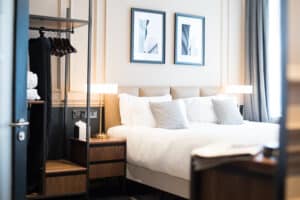Trends permeate every aspect of the design industry, driving sales and reinvigorating the marketplace year on year. For many, the latest trends are something to look forward to, an opportunity to reinvent yourself or your business, throw out the old and replace it with something new and improved—at least that is the theory. However, despite society’s broad acceptance of frequent style changes and the blurring of lines between needs and wants, I’d argue that overall, trends benefit few. In fact, they negatively impact the majority of us. So, if designers want to benefit clients and protect the environment, stop following trends.
Some trends are naturally occurring because when something is popular and beneficial, it draws in the masses. But others are manufactured, and these are highly problematic when tied to a growing culture of consumerism and waste. When starting a new interiors project, there is a tendency to want to strip everything back and start with a blank canvas. But I always believe the best approach, environmentally and commercially, is to sit back and assess the value of what you are inheriting. After all, the best projects are heavily influenced by the history of a building, the cultural setting, and the context. For me, one of the primary jobs of an interior designer is to see value where others are blind. To shine a light on something that looks tired and worn and create something of lasting popularity and relevance.
Conformist, trend-led approaches create generic design outcomes, diminish creativity, and erode culture. They result in repetitive copy-paste solutions that can be found anywhere. Often, an interior in London has little to differentiate it from an interior in New York, Melbourne, or Dubai. They fail to celebrate context and place. They create monocultures, which are not helpful to designers, especially if you want to create distinctive outcomes and separate yourself from the competition.
Trends do have value commercially. However, their value is in boosting product sales, which is achieved by accelerating obsolescence and generating waste. Historically, built-in obsolescence was about a technical and terminal product failure that would require the customer to make a new purchase. But there are many more sophisticated ways to encourage people to replace old things with new ones. Fashion cycles or style changes are highly effective ways to promote and encourage the replacement of goods when the previous model remains unimpaired in its utility. It is wrong to think that trends are there to benefit customers. Their primary role is generating sales, pure and simple. Because of this, many clients put themselves at a disadvantage because they blindly adopt what is current and in fashion. However, in doing so, you build obsolescence into your business and force yourself into a cycle of reinvention and reinvestment to stay commercially relevant.
So, where does this leave us? Trends encourage us to consume, and the desire to consume inevitably leads to wasted material, energy, and money (at least from a client’s perspective). By following the latest styles, businesses adopt an outcome-based design approach, applying a product or material to a space because of fashion rather than relevance. But we prefer a process-driven approach to design because it values culture, context and the environment.
Opposing the idea of manufactured trends is not the same as being opposed to change. On the contrary, change is both good and necessary. Especially as the design industry directly contributes to a vast array of social and environmental problems. We need a culture that values innovation and encourages change. That appreciates good design en-masse and only replaces it with something of genuine benefit and value.
As sustainability in design becomes more widely debated, I often hear people say it is in danger of becoming another short-term trend. But for me, this should never be the case. When it comes to design, understanding the environmental and social impact of your work should be at the forefront of your mind, and this is never a question of style, trends or even sustainability. It is simply a question of good and bad design. A principle that should never go out of fashion.




